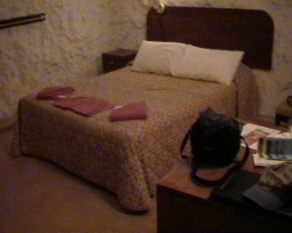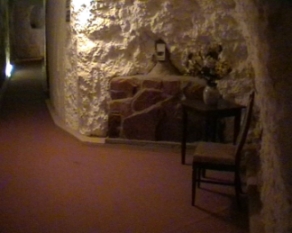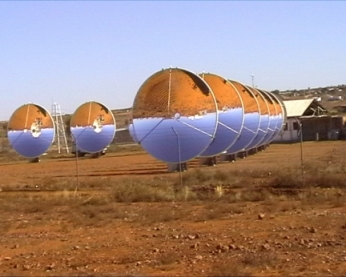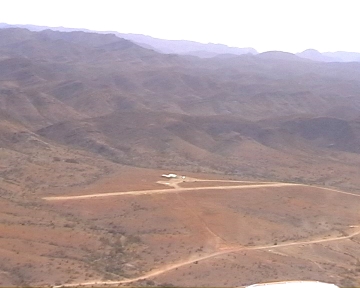By David Hill - Owner of FJF


We did this trip to White Cliffs and Arkaroola in FJF some years ago, so you may need to check currency of the details, – However we can thoroughly recommend either of these locations as a weekend flying destination or en-route stopover for your next safari into outback Australia. The following is a summary of our experience for anyone else who may be interested in a similar trip into remote Australia.
Day 1: Camden - White Cliffs
| We had excellent weather on our departure from Camden, and tracked
direct to Katoomba, taking in the magnificent views and spectacular
escarpments of the Blue Mountains as we climbed en-route to our cruising
altitude of 6,500 ft. As the Three Sisters slipped away to our left, we
continued on our westerly heading overflying Bathurst, Parkes, and
Condobolin before turning northwest towards Cobar. Soon the green mosaic
of farmland and rolling hills below were replaced by the brown and grey
shades of low scrub and Spinifex. From Cobar, the course to our destination of White Cliffs lay 146 nm due west over some very remote country. From here, the ground features consisted only of undulating sand hills, spotted with dried saltpans and the occasional isolated homestead. Thirty-seven minutes later we confirmed our groundspeed and our track with a positive fix over the mighty Darling River. Even in this age of GPS, I still plot 10-mile markers on my WAC chart and note time intervals (4 minutes in FJF) to help navigation - particularly over isolated country. Twenty minutes later we could make out our destination airfield amidst the distinctive “lunar like landscape” of white mounds and craters that mark the outback opal-mining town of White Cliffs. While overflying the field to check for wind direction, we also made a careful scan for kangaroos. After shutting down, to our surprise we opened the door to a Golden Labrador who had climbed aboard the wing to greet us. We subsequently learned that she was no stranger to flying and was excited at the prospect of joining John, one of the locals, on a trip away to Norwood Station (another great destination). We watched as she climbed aboard John’s Gulfstream and eagerly settled into the back seat, completely at home. After tying down the aircraft, we made our way to a car that had been left at the airport by the hotel for our use during our stay. As we headed off along the dusty road into town, I caught some strange looks from the family as they gazed at the barren landscape. Why had we come here – there was nothing to be seen - not even any houses. Apart from the general store, hotel, post office, school and a couple of other shacks, almost all of 350 White Cliffs inhabitants live underground in homes converted from disused opal mines or burrowed into the surrounding hills. |

|
We made our way through “town” and followed the signs to our accommodation – the Underground Motel.
Leon, the owner, immediately made us feel at home as he lead us through the
meandering tunnels with various rooms dug out on the sides. We found the
accommodation to be very comfortable, and the novelty certainly made up for the
lack of ensuite facilities, television and telephone.
 |
 |
The remainder of the afternoon was spent taking in the somewhat surreal ambience of the area, including the local golf course of dust and rocks – not a blade of grass to be seen!! This was followed by a quick swim in the pool. We met up with some other tourists who had taken three days of solid travelling by road from Sydney –compared to our three hours by air! Leon and his wife provided a sumptuous three-course meal, before we collapsed into our beds underground.
Day 2: Tour of White Cliffs
| Following a good night’s sleep, we settled down to a hearty country
breakfast of eggs and bacon. We then met with Ross, our local guide, who
provided an entertaining and informative three-hour tour of White Cliffs
and the surrounding area. Highlights included history of the Opal Mining
area, tour of the experimental solar station that supplies power to part
of the town, a visit to a local artist who paints the most magnificent
landscapes, and a tour of the opal mines.Ross also kindly showed us
through his own underground home.
Naturally, our visit would not be complete without some “retail therapy” provided by some of the exquisite local opal show rooms |

"THE EXERIMENTAL SOLAR STATION" |
.
During the afternoon, we joined a tour of a working opal mine. The entrance of the mine also displays the ancient bones of a Pleasiosaurous, lying as they were uncovered during the excavation of the mine.

Later that evening, following another magnificent three-course meal, Leon turned off all the external lights and invited us outside to gaze at the night sky. The lack of any ground lighting made the stars and the Milky Way stand out vividly in the ink black sky.
Day 3: White Cliffs – Arkaroola
 |
Next morning we felt as if we were leaving life long friends as we
said our good-byes and set off on a leisurely drive back to our waiting
aircraft. Having refuelled the day before (Leon also has a tanker to
supply Avgas), we were soon ready to depart. As part of the pre-flight, we
carefully cleared the countless stones scattered beneath the prop. Next
time I would recommend including a small dust pan and broom in the tie
down kit!!
As we made a climbing turn onto our westerly heading, the “ants nest” landscape of white mounds and craters below were somehow less alien than when we arrived. Our next destination was Arkaroola, which lay a short 80 minutes to the west over even more barren land. The vermin proof fence cut into the Strzelecki Desert clearly marked the NSW-SA boarder below. The ride for the entire flight was so smooth - it was like skating on ice. There was no sign of the thermals normally generated by the contrasting expanse of white salt of Lake Frome stretched out below. Looking ahead, the North Flinders Ranges rose abruptly out of the desert |
| The Arkaroola strip is nestled between two lower ridges at the foot of
these spectacular ranges. A Ranger responded to my “all stations” call, and advised he was already on his way to the strip to meet us, which meant that there was no need to overfly the Arkaroola village to signal our arrival as arranged. The 03/21 shale strip is 650m long. The wind was across the strip, so I decided to use 03, which is up hill. It is advisable to make a right circuit into 03 to remain clear of higher ground to the west. Also, be ready for wind shear as you cross over a dry creek bed immediately before the threshold. The ranger met us with a friendly smile, and helped push FJF back into the hangar. In no time we were on our way to the Arkaroola lodge, slowing to watch an “old man” Emu with six of his almost fully-grown off spring. The ranger explained that after laying the eggs, the female leaves the job of hatching and rearing to the male. Apparently the producing and laying of the eggs takes so much out of the mother that she needs the rest |
 |

"SILLERS LOOKOUT" |
After booking into the lodge, and a quick lunch, we departed on the
4WD Ridge Top tour. This three-hour journey takes in some of most breath
taking and acient country we have ever seen. Although, the ride was
significantly more bumpy than the flight!
The highlight is afternoon tea on top of the world at Sillers look out.
|
| That evening, we joined Doug for an astronomy night from his home built observatory that is perched on top of a hilltop overlooking the Arkaroola village. Once again, the remoteness of the area and lack of ground lighting makes for one of the best locations in the Southern hemisphere for viewing the heavens. We each took turns gazing through the telescope as Doug identified various stars and constellations – millions of light years away. As we retired that evening, we felt very humble and insignificant in the overall scheme of things. |  |
Day 4: Arkaroola – Mildura

|
After a leisurely breakfast, the ranger kindly transported us back to
our aircraft. Doug can also provide a complimentary car that is usually
available to aviators who wish to spend some more time exploring the area.
I visually confirmed the fuel remaining was sufficient and so was no need to refuel. Doug has also laid a small paved area for engine run up to avoid prop damage from the prolific stones that make up the airfield. Once again, the wind was across the strip, so we lined up on 12 to take advantage of the downhill gradient for take off, and used the vernier throttle to progressively increase power to avoid picking up stones. As we passed the taxiway about 2/3 the 650 m length, I checked the airspeed was rising through 60 knots. (Doug advised that he always checks that he has at least 80% of takeoff speed by this point – which was around 55K IAS in FJF). A few seconds later at 70K, we took off effortlessly and climbed away. After a climbing turn to take a last look at the Ranges, we set a course for Broken Hill, which was our first point en-route to my hometown of Mildura – just 2 hours to the South East. Once again the flying conditions were smooth. I tuned the ADF and was amazed to see the needle swing and point dependably to Broken Hill – 145nM away. The white expanse of Lake Frome reverted to a vastness of rolling sand hills, gradually giving way to low scrub and occasional stand of trees. |
Soon the ranges that marked Broken Hill rose out of the flat terrain.
Broken Hill can provide an interesting stopover point, with informative tours of the working mines, or a visit to the ghost town of Silverton.
However, this time we overflew the field and continued direct to Mildura.
From the air, it is evident to see why Mildura is often referred to as an “oasis in the desert” - the green vineyards and orchards forming a stark contrast amidst the surrounding barren landscape.
The airport facilities are excellent. However, it is worth checking if the refueler is around to avoid a possible “call out” fee on the day of your departure.
A courtesy telephone in the terminal connects directly to the resident airport bus operator, who charges a very reasonable fee to transport passengers into town. Alternatively, there is a selection of rental cars at the airport.
Mildura is a popular tourist location, and so has a wide choice of accommodation. The Grand Hotel is a good selection. Situated in the centre of town, this majestic old hotel is a short walk to the Murray River and most attractions.
Day 5: Tour of Mildura
| There is a vast choice of activities including Paddle Boat cruises,
shopping, fishing, water skiing, visit to the pioneer settlements and
Chaffey Homestead/museum etc.
Also worth a visit is Woodsy’s Rock Shop. This unique place has an amazing display of precious stones and jewellery collected from around Australia. If you did not get enough underground experience in White Cliffs, there is even an artificial cave. A garden maze is guaranteed to keep you wandering in circles indefinitely. If you have “12 hrs between bottle and throttle”, go visit the longest bar in the world at the Working Mans Club. The local gliding club is also very active on weekends if you are looking for a quieter way to see the surrounding area. |
 |
Day 6: Mildura - Camden
Our route on this last day of our journey towards home lay just over 3 hours flying time east to Camden. FJF is IFR, but we had planned VFR for this trip. A low overcast cloud base kept us below 2,000 ft before we found a “hole” overhead Norwood Station. We quickly climbed through the gap in the clouds and settled to cruise at 7,500 ft bathed with brilliant sunlight, in stark contrast to the grey, drizzle we had left below us.
We remained above this fluffy carpet of cloud as we tracked over the aid at Griffith, and then on to Cootamundra before the cloud became broken, then scattered at Goulburn - true to the forecast.
The Hume Highway clearly marked the way through the now familiar, picturesque green countryside to Mittagong, where we left the highway direct to The Oaks, and then – sigh - on to Camden.
ROUTE SUMMARIES:
Camden – White Cliffs
|
Alternative “Low Route”
|
White Cliffs – Arkaroola
|
Arkaroola – Mildura
|
Mildura – Camden
|
|
|
|
|
|
|
| ||
|
|
|
|
|
|
|
|
|
|
|
|
|
|
|
|
|
|
|
|
|
|
|
|
|
|
|
|
|
|
|
|
|
|
|
|
|
|
|
CONTACTS
| • White Cliffs Underground Motel | 1800 021 154 or (08) 8091 6677 |
| • Arkaroola (Accommodation) | (08) 8648 4848 |
| • Mildura (Accommodation) | 1800 03 9043 |